|
When this January 1948 issue
of Radio News magazine was published, a mere two and a half years had passed since
the end of World War II, and military planners were already strategizing about
what a future war might look like. Two technologies that had a huge effect on the
previous efforts were the atom bomb and the guided missile; therefore, they were
prominent in discussions. Germany's use of the
V-1 Buzz Bomb is a familiar
example of a guided missile that struck terror in the hearts of populations that
experienced its devastating destructive power. Ditto for the
V-2 rocket. The U.S. developed
a few missiles of its own, particularly immediately after WWII when it had the assistance
of Werner von Braun
and other notable rocket scientists who worked for the U.S. space effort after the
war. A few of the missiles are on display today at the
Udvar-Hazy center of the National Air and Space Museum.
Guided Missiles
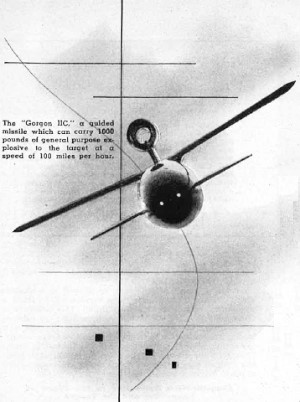
The "Gorgon IIC," a guided missile which can carry 1000 pounds
of general purpose explosive to the target at a speed of 100 miles per hour.
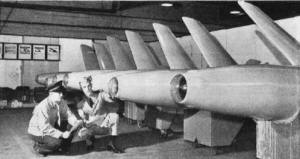
A group of guided missiles undergoing final inspection at the
Naval Air Modification Unit, Philadelphia. Each of these pilotless aircraft is equipped
with an intelligence unit enabling it to seek out and carry its explosive load directly
to the chosen target.
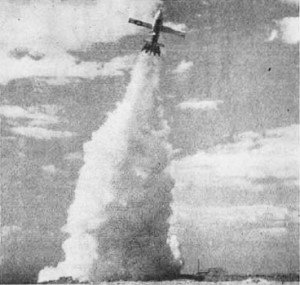
Guided missile roars into the air with the aid of four Mons-auto
rockets. After expiration of the thrust of 40,000 pounds, the rockets and sled will
fall free and the "Loon" will head out over the Pacific to its target.
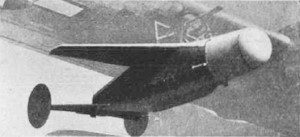
Launched by Navy "Privateer" patrol bombers outside the range
of enemy anti-aircraft fire, and guided to distant targets by radar, these Navy
"Bat" bombs sank many tons of enemy shipping. Operating on somewhat the same principle
as live bats, which emit a short pulse of sound and direct themselves by the echoes,
robot bats are guided by radar echoes from the target. Approximately 12 ft. in length,
with a 10 ft. wing span, the "Bats" carry a heavy load of high explosives. Two "Bats"
are carried by each "Privateer," the Navy's giant patrol bomber.
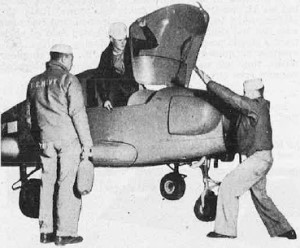
Navy target drone, used for gunnery training of Navy personnel,
is pre-pared for a test flight by its crew.
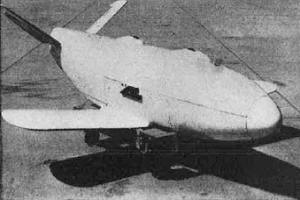
The "Gargoyle," an air-to-ground, radio-controlled powered glide
bomb, carrying a standard 1000 lb. general-purpose or armor-piercing payload. It
can be launched from airplanes.
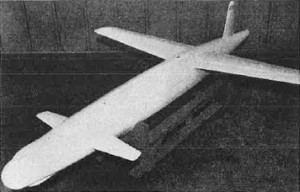
The "Gorgon," a guided missile resembling a freak-tailed white
shark, carries a 100-pound, specially-shaped charge and is sent at a speed of 550
m.p.h. through air, by a rocket power plant.

The TD2N-1, an air launched target, jet powered guided missile.
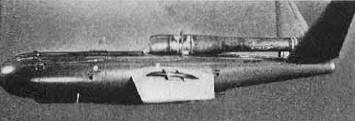
The KDD "Katydid," a jet-propelled, radio-controlled pilotless
drone used as a practice target for lighter planes. The span is 12 feet. 2.6 inches,
and the length is 11.1 feet. Equipped with a resonating jet engine equivalent to
45 hp. and having a speed of over 200 m.p.h., it can perform all the maneuvers of
a fighter plane through radio control of the "rudder-vators" In its V-shaped tail.
It can remain aloft 40 minutes, when a parachute packed under the forward hatch
is released by a radio signal. This turns off the jet and allows the drone to float
to earth where it can be recovered for further use.
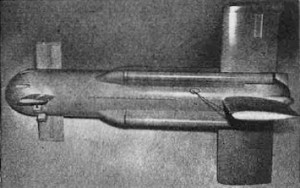
The KAN-1 or "Little Joe," a short-range anti-aircraft missile
designed to be launched from a shipboard catapult, with the aid of standard rockets.
It is radio-controlled, flare-sighted, and powered by "JATO." a Navy-type solid
fuel rocket.
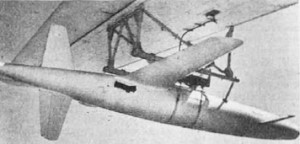
The "Gorgon" slung underneath a Navy PB4Y-2 (Navy modification
of Consolidated-Vultee's Army B-24 four-engine heavy bomber) ready for test flight.
This is an air-to-air guided unit.

The KUW-1, "Loon," pilotless aircraft propelled by jet engine.
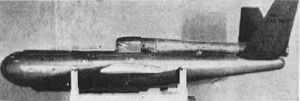
Another type of jet powered target missile being used by the
Navy. Known as the KDD-1 "Katydid," it is designed to be launched either by catapult
or from a target-carrying aircraft.

Mockup, or exact sized model of the KAQ-1, popularly known as
the "Lark," one of the air-launched test-type guided missiles.
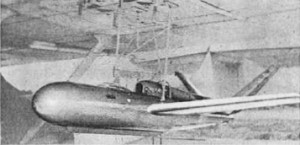
A radio-controlled, jet-powered target drone resting in its launching
rack under the wing of a Navy PBY. This is a small pilotless aircraft whose flight
can be made to simulate suicide dive bombers and torpedo plane attacks. Working
on the principle that a "few hours on a drone is worth two weeks of any other kind
of gunnery training," the Navy went all out to develop target drones for the benefit
of its anti-aircraft gunners. These target drones were frequently used while the
fleet was on its way to and returning from attacks against the enemy and proved
far more popular with the gunners than the usual type of towed sleeve targets used
by the Navy before the development of this type of more realistic target.

The KUN-1, or "Gorgon IIC," a catapult-launched, jet-powered
guided missile, is shown mounted on a movable rack.

The "Glomb," Model LBE-1, a television-controlled glider-bomber
which can withstand a speed of 300 m.p.h. in a 4 G dive. This is one of a atrio
of pilotless craft of the same guided missile family, the others being "Gorgon"
and "Gargoyle."
By C.E. Chapel, 1st Lieut., U.S.M.C. (Ret.)
Consulting Ord. & Aero. Eng. and Chief of Research & Development, Northrop
Aeronautical Institute.
A new era of pilotless aircraft for war and peace has been inaugurated. Radio
and electronic equipment again plays major role in these developments.
The atom bomb and guided missiles will be the principal weapons for the defense
of the United States of America in any future war. None of us want war, but we all
want to be ready for it if it comes. Radio operators, radio technicians, radio servicemen,
and everyone who has the slightest interest in the broad field of electronics should
possess a basic understanding of the fundamentals of guided missiles. Reduced to
their simplest terms, they are nothing more than new applications of vacuum tube
circuits.
Definition of Guided Missile
In order to obtain a clear idea of the design, construction, and operation of
guided missiles it is necessary to agree upon certain terms which are commonly used.
First; a missile is a weapon which can be thrown or projected through space, such
as a spear, an arrow, or a bullet. Each of these objects is guided along its flight
path at the moment of its launching, but thereafter it is subjected to various external
forces that affect the accuracy with which it travels toward the target.
Second, a guided missile may be defined as a weapon which travels through space
and carries within itself a means for controlling its path of flight. This definition
is broad enough to include bombs, rockets, and even conventional airplanes. For
example, a pilotless aircraft is a guided missile having aerodynamic surfaces large
enough to supply the principal support for the aircraft in flight. Therefore, the
lessons learned from the operation of pilotless aircraft may be applied in the design
and construction of other forms of guided missiles.
Classification According to the Place of Launching and the Target
Guided missiles may be classified according to the place of launching and the
target. In general, they may be launched from the surface of the earth, either from
the land or from the sea, or they may be launched from some type of aircraft. Thus,
they may be launched from the ground, from a ship, or from an airplane.
In a similar manner, guided missiles may be classified according to their targets,
which may be ground installations, ships, or aircraft. Considering the place of
launching and the target together, the classification breaks down into the following
types: (1) Ground-to-air, (2) ship-to-air, (3) ground-to-ship, (4) ship-to-ship,
(5) ground-to-ground, (6) ship-to-ground, (7) air-to-air, (8) air-to-ground, and
(9) air-to-ship.
One guided missile may be used in two or more of the above classifications. For
example, an air-to-ground missile may be successfully employee as an air-to-ship
weapon. This does not necessarily mean that the same type may be used efficiently
for both military and naval purposes because the launching conditions are often
different and the tactical considerations present entirely different problems. Thus,
a guided missile which can be launched from a heavy bombardment airplane may be
too large and heavy to launch from a comparatively small carrier-based airplane.
In the same manner, a missile which may be fired from the ground against airplanes
may be too large and heavy for a ship to launch against enemy suicide airplanes.
Furthermore, in many instances it would be a waste of valuable armament to launch
a large guided missile against a relatively small or unimportant target when the
same weapon may be needed later for an appropriate target.
Classification According to Method of Propulsion
A missile may be dropped from an airplane like a rock, in which case it merely
possesses the altitude and speed given to it by the flight of the airplane, and
it is brought to earth by the force of gravity. It may be fired from a gun aboard
an airplane, it may be launched from an airplane by means of a rocket, or it may
be given an initial acceleration by means of a rocket motor and thereafter be self-propelled.
It is obvious that any of the methods used for launching a missile from an airplane
can be used for ground launching except a method which depends on the force of gravity.
Of course, in theory, a missile could be launched from a high tower erected on the
ground but structural limitations make this foolish, although it must be remembered
that this method was used in ancient times.
We now come to a method of propulsion which is suitable for missiles launched
from either the ground or the air, and this is the use of self-propulsion, which
simply means that the missile contains a power plant of some description. The power
plant may be a reciprocating engine with a a propeller, a gas turbine with a propeller,
a turbojet motor, a ramjet motor, an aeropulse motor, or any other kind of power
plant which will drive the missile along its path through the air.
The missile may or may not have aerodynamic surfaces, that is, it may or may
not have wings, ailerons, a rudder, an elevator and other surfaces for controlling
its flight path. For example, glide bombs have been used, both with and without
wings and it is possible to use rockets, either with or without wings. Pilotless
aircraft using conventional types of power plants are too slow to be effective and
too large to escape enemy detection and destruction, hence they may be eliminated
from our classification of modern, practical, guided missiles. Bullets, bombs, and
artillery projectiles as we have known them in the past should be eliminated from
our thinking because they are not adaptable to self-propulsion. In general, modern
guided missiles fall into two principal classes: (1) Rockets, either with or without
wings,: and (2) Pilotless aircraft with some form of jet propulsion.
Classification According to the Method of Control
Before we approach the control of guided missiles, we should have a basic understanding
of the control of conventional airplanes. The aileron is a hinged, movable portion
of a wing, the principal function of which is to impress a rolling motion on the
airplane. By raising one aileron and lowering the other, the pilot can roll his
airplane to the right or left. The rudder is a movable surface hinged to the trailing
edge of the vertical stabilizer, used to steer the airplane right or left. The elevator,
usually hinged to the trailing edge of the horizontal stabilizer, is used to raise
or lower the nose of the airplane in flight. These three types of control surfaces
control the three fundamental rotational motions of an airplane.
In order to relieve the pilot of work, the autopilot was developed. In its simple
form, it may be set by the pilot on a course and thereafter it operates the ailerons,
rudder, and elevator to keep the airplane on a straight and level path. Autopilots
used in World War II were either hydraulically or electronically operated and where
used in flight but were not extensively used for take-off or landing. However, autopilots
are now developed so highly that they may be set on the ground and used from take-off
to landing without the intervention of a human pilot in the operation of the control
surfaces.
Coming back to guided missiles, in World War II, the Germans used the types known
as V-1 and V-2 with considerable success. The V-1 was a pilotless aircraft and the
V-2 was what is technically described as an elliptical-trajectory rocket. Both of
these were guided by autopilots. The operators determined the location of the target
with regard to the place of launching, estimated the wind drift, computed the required
settings and then applied these settings before the missile was launched. The operator
had no control over the flight of the missile after it was launched and the missile
did not receive any information, intelligence, or guidance from the target. The
accuracy of its fall upon the target depended upon the accuracy with which the autopilot
was constructed, the accuracy of its setting, and the computation of wind drift
by the operator, although the latter factor was not as important in the case of
the V-2 missile as it was in the case of the V-1. The only electronic feature was
the operation of the autopilot, assuming that it was not of the hydraulic type.
The next step in the development of guided missiles was to use an autopilot but
control it remotely by the exercise of the judgment of a human pilot. The human
pilot had to keep both the missile and the target under observation constantly and
exercise his remote control by means of radio. During the night or during foggy
weather, this method did not work, and even during daylight hours, under conditions
of maximum visibility, the anti-aircraft fire of the enemy and the interception
of enemy fighter airplanes reduced its effectiveness.
Having achieved some success with radio-controlled guided missiles under the
observation of the remote pilot, the next step was to install a television transmitter
in the missile so that it could "see" the target, that is, it would transmit its
reactions to the emission and reflection of light from the target, and thus enable
the human pilot to direct its flight by radio. Obviously, if the emission and reflection
of light from the target was weak, or if there were light rays from objects other
than the target, the accuracy was greatly lowered. This limited the effectiveness
of this method so much that the scientists turned their attention to the use of
radar.
In theory, targets which give good radar reflections can be attacked regardless
of the visibility, thus overcoming the objection to the use of television repeat-back
information, and enabling the remote human pilot who has the necessary. information
regarding the range and direction of the target to direct the guided missile on
an accurate flight to the target. However, if the target does not emit or reflect
radar signals, this method fails.
Another theory is that if the remote human pilot knows the exact location of
the target on a map, he can track the flight of the missile by radar, plot its course
on the map, and then direct its course by radio so that it will dive at the proper
moment and hit the target.
A third theory is that a radar beam may be directed along the path which the
missile is to follow. In this case, the missile must carry equipment which will
enable it to follow the radar beam. The advantage to this theory is that if the
target, such as a ship, an airplane, or any other movable enemy object, changes
its position, the radar beam may be directed to the new course of the target and
the missile will still strike the target. Again, a human pilot must be on watch
from the moment of launching until the fall of the missile on the target.
These theories based on the use of electronic equipment have been seriously considered
by scientists for several nations, but the necessity for controlling the missile
by the exercise of the judgment of a human pilot has not been as attractive as the
possibility of developing a missile which would automatically seek the target.
Target-seeking guided missiles are sometimes called homing missiles, but this
term suggests the return of the missile to its launching point, hence it is better
to refer to them as "target seeking."
Although electronic engineers play a vital part in the development of guided
missiles, they are broad enough in their thinking to consider all physical laws
in searching for new methods. For example, they have discussed the possibility of
guiding missiles to their targets by means of the emission or reflection of sound
at the target. This depends upon the intensity and direction of the sound at the
target. Battlefield noises, and even the ordinary industrial noises, reduce the
effectiveness of this method, but the problem becomes hopeless of solution when
it is realized that the missile itself produces noise, both internally and externally,
as it travels through the air.
The emission of light from flares or searchlights, contrasts between light and
Dark areas, and similar light conditions at the target could be used as sources
of guidance for target-seeking missiles but here again we would be faced with the
obstacle of varying conditions of visibility.
The emission of heat rays from the smokestacks of ships, industrial plants, and
similar targets, may be used as a source of guidance, but this method is limited
because of varying weather conditions, and fluctuations in the generation of heat
at the target. Heat and light are both within the electromagnetic spectrum, hence
they emit or reflect electromagnetic radiation, but they do not do either as well
for our purposes as radar, which is reliable night or day, regardless of weather.
In the application of radar to the control of guided missiles, two entirely different
systems have been tried. In . one, the missile contained only a receiver. The
transmitter was on the "mother" airplane and emitted short pulses of high intensity.
Mechanisms within the missile which kept it pointed toward the target were activated
from the returning echoes.
In the other type of radar-controlled missile, the missile is set for a particular
target, released, and then it automatically follows every movement of the target
until it strikes, leaving the mother airplane entirely free to go on another mission.
The principle underlying the operation of this fully automatic target-seeking
missile resembles that used by a live bat which gives out short pulses of sound
and is guided by echoes from the sound, thus avoiding collisions in the dark. The
missile emits pulsed microwave electromagnetic radiations and is guided by the radar
echoes from the target. Since the missile can follow every movement of the target,
it is possible to say that the radar robot pilot inside the missile can "see" the
target under all conditions of visibility.
A missile of this type can be carried under the wing or fuselage of an airplane
and released several miles from the target. The usual procedure is to first locate
the target by means of the standard search radar carried by the airplane. The airplane
is then flown toward the target and the radar transmitter and receiver in the missile
are aimed in the same direction. Target information received and transmitted from
the radar in the missile is displayed on a special indicator in the airplane and
controlled by the operator. As soon as the radar equipment can be manually adjusted
to the prevailing conditions, it is switched to automatic tracking and the missile
is released.
Echoes from the target are continuously detected by the radar receiver installed
in the missile. The flight control units receive corrective signals from the output
for the purpose of guiding the missile toward the target.
The advantages of this fully automatic, target-seeking missile are as follows:
(1) The self-guiding feature enables the launching airplane to go on another mission
and maneuver as desired: (2) The self-guiding or homing feature increases the accuracy:
(3) Heavily armed targets outside the anti-aircraft range may be accurately attacked.

C. G. Pierce of Los Angeles, electronics engineer for the General
Electric Company. and B. L. Dorman. chief test engineer of Aerojet, view the television
installation in the test pit prior to televising the test of firing high thrust
rocket motors at Aerojet Proving Grounds. Developed by Aerojet engineers, this method
of televising rocket motor tests was successfully demonstrated with the cooperation
of engineers of General Electric Company who furnished the television equipment.
This method, used for the first time anywhere, provides safety from the hazard area
to observers located in a remote room who may view the tests with added advantages
of better lighting and close-ups never before provided.
The system just described was installed in the "BAT," the first fully automatic
guided missile successfully used in combat by any nation. It was one of several
guided missiles developed by the National Bureau of Standards under the sponsorship
of the Bureau of Ordnance of the Navy Department and has led to further research
on advanced designs.
Statements in this article are the personal opinions of the author. They are
not to be construed as necessarily reflecting the official opinions of the Navy
Department or the naval service at large.
Posted September 1, 2021
(updated from original post on 5/13/2013)
|



























